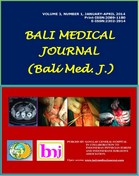IMMUNE RESPONSE AND COST ANALYSIS OF INTRADERMAL RABIES VACCINATION FOR POST-EXPOSURE PROPHYLAXIS REGIMEN IN HUMAN
Abstract
Background
The outbreak of rabies in human in Bali-Indonesia is causing an extraordinary pressure for the government in providing adequate doses of anti-rabies vaccine for post-exposure prophylaxis (PEP). Here, we directly compare the immune response and benefit of the intradermal (ID) protocol for rabies vaccine delivery with the intramuscular (IM) route. Methods: Sixty health workers who were willing to participate in this study have been randomly selected and grouped into ID, IM, and control groups, each with 20 volunteers. The Thai Red Cross ID- and Zangreb IM-protocols have been applied to the respective group. The sera of the volunteers were collected at day 0, week 1, week 3, week 4, month 3, month 6, month 9, and month 12 after the first vaccination. Anti-rabies virus IgG was detected using PlateliaTM Rabies II Kit (Bio-Rad). Results: Anti-rabies IgG could be detected in the ID-group at one week. The ID-vaccine delivery induced a slightly higher maximum antibody titer compared to IM, though not statistically significant (p>0.05). ID vaccination caused less adverse reactions and produces longer lasting protective immune response. Cost minimization analysis (CMA) on the provincial and national PEP data in 2009-2011 shows that the ID-delivery will reduce the total cost for a completed regimen by USD 28.5, and would have saved the Indonesian government budget approximately USD 3.6 and 4.3 million for complete regimens in Bali and Indonesia, respectively. Conclusion: The ID administration of anti-rabies vaccine induces a similar immune response compared to that of intramuscular injection. It also produces longer lasting protective immune response. It offers additional advantages of potential net cost savings as well as decreasing the pressure on vaccine availability due to the high number of dog bite cases.


